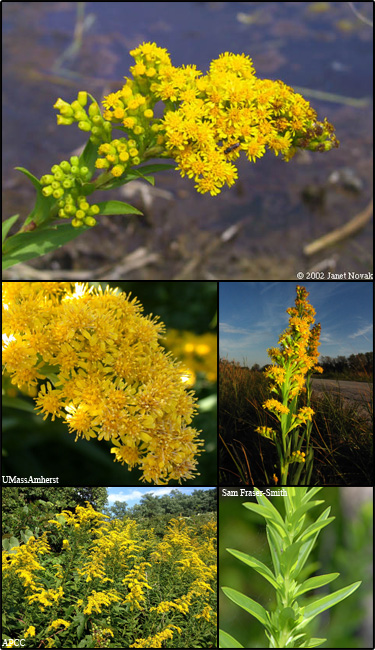Seaside goldenrod (Solidago sempervirens)
 Common Names: Salt-marsh goldenrod, evergreen goldenrod
Common Names: Salt-marsh goldenrod, evergreen goldenrodDescription: Sold as an ornamental for wildflower gardens.
Habit: Perennial goldenrod tolerant of standing water, drought, and saline soils.
Leaves: Basal leaves are narrowly ovate to oblanceolate tapering to a winged petiole. Up to 22 inches long and commonly 1.5 to 2.5 inches wide. Stem will have alternating leaves. Leaves on stems are much smaller and get progressively smaller going up the stem. Typically 2-3 inches long and 0.5 inch wide. Stem leaves are lanceolate and sessile.
Stems: Woody caudex, without rhizomes and grow between 18 inches and 10 feet tall.
Flowers: Deep yellow-golden in color, composite flowers that have disk and ray florets. Inflorescence is pyramidal and flowering occurs from top to bottom.
Fruit and seeds: Prolific seed producer.
Habitat: Native to the eastern coastal North American. Found in wetlands, prairies, dunes, marshes, lakeshores and roadside ditches.
Reproduction: By seed.
Similar species: Other species of Goldenrods (Solidago spp.).
Monitoring and rapid response: Use an herbicide that contains picloram. Spray each individual plant with herbicide. Wet each plant thoroughly until plant is saturated, but not to the point where herbicide will drip. Allow one growing season to pass before mowing. Credits: The information provided in this factsheet was gathered from the Wisconsin Department of Natural Resources and the University of Florida IFAS Extension Lee County.
Individual species images that appear with a number in a black box are courtesy of the Bugwood.org network (http://www.invasive.org).Individual photo author credits may not be included due to the small display size of the images and subsequent difficulty of reading the provided text. All other images appear courtesy of Google (http://images.google.com).
Common Name: | Seaside goldenrod |
Scientific Name: | Solidago sempervirens |
Family: | Asteraceae (Aster) |
Duration: | Perennial |
Habit: | Herbs |
USDA Symbol: | SOSE |
